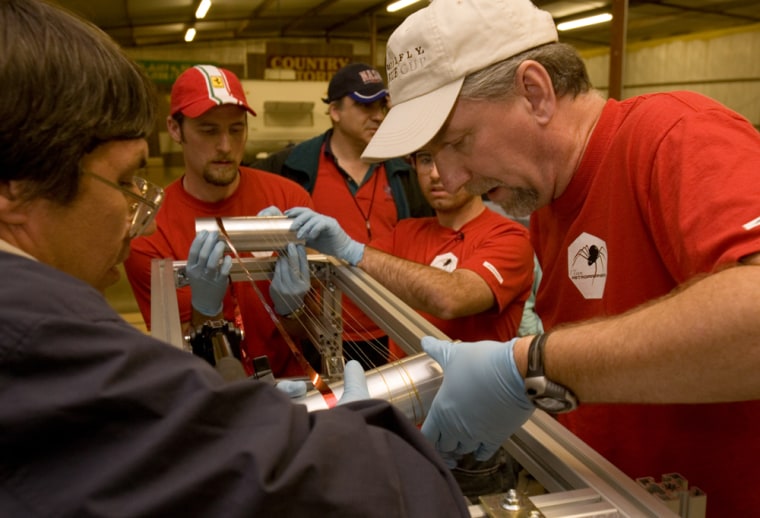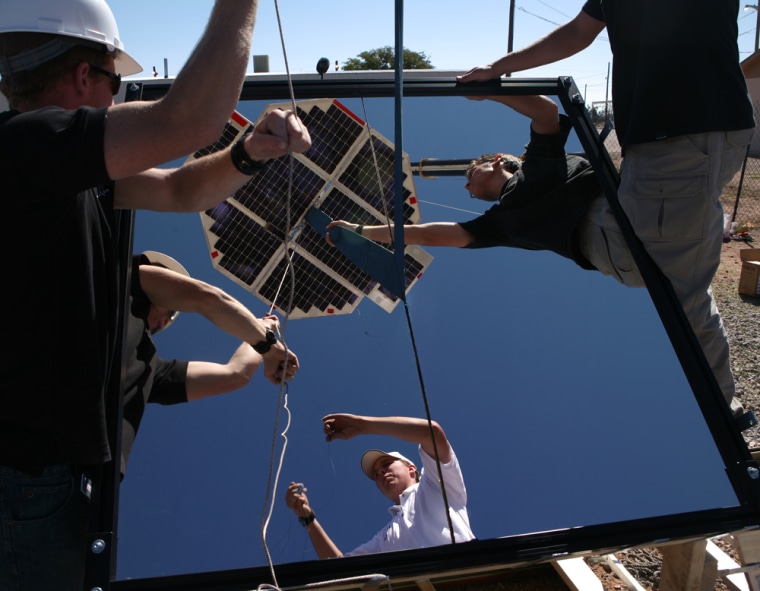LAS CRUCES, N.M. - Two seconds.
That's how close students from the University of Saskatchewan and their international colleagues came to winning $150,000 in the Space Elevator Games, held here this weekend in conjunction with the Wirefly X Prize Cup rocket festival.
The competition, organized by the Spaceward Foundation under the auspices of NASA's Centennial Challenges, aims to promote technologies that could be used in next-generation power systems and planetary rovers — and perhaps someday in robots capable of climbing a 62,000-mile-long (100,000-kilometer-long) ribbon to orbit, known as a space elevator.
At this weekend's games, however, a 50-meter-long (164-foot-long) ribbon strung from a construction crane was more than enough of a challenge for a dozen teams.
On Saturday night, the Saskatchewan team members thought they had qualified for a prize by sending their beam-powered robot up the ribbon in less than a minute. That's how the objective of the games' Beam Power Challenge has typically been described.
Unfortunately, that description is a bit imprecise: According to the rulebook, the bar that had to be met was a climbing speed of 1 meter (3.3 feet) per second.
The Saskatchewan team covered the length of ribbon in an official time of 57 seconds, but by Sunday, the Space Elevator Games' judges determined that the length measured 55 meters. Thus, the Saskatchewan team had taken just two seconds too long.
"I honestly thought that this year was the year NASA would pay out their first Centennial Challenges purses, but it was not to be," Ken Davidian of NASA's Centennial Challenges program told MSNBC.com in an e-mail.
Debate over the rules
Some of the other teams in the Beam Power Challenge questioned whether the Saskatchewan team had followed all the lesser-known rules governing the competition, including one calling for a controlled descent of the climber after its ascent. But the Spaceward Foundation's Ben Shelef told the students that speed was the determining factor.
"You guys were by far, by far the strongest contenders," Shelef said at the Southern New Mexico Fairgrounds near Las Cruces, where the games concluded Sunday. "Had you done 55 [seconds], then no other team could say, 'Wait a minute, why aren't they satisfying all the procedural requirements?'"
The Saskatchewan team's initial reaction was dismay — and even disagreement with the judges' verdict. But after a while, team members took a more philosophical stance.
"It's frustrating not to hit that 1 meter per second, but we were just below. And it's going to happen — next year, if not this year," said team leader Clayton Ruszkowski.
The team's treasurer, Wah Sen (Barry) Chan, said the verdict wouldn't be disputed: "There's no point in throwing rocks," he told MSNBC.com.
The pain of rocket science
In the end, all three of the NASA prize challenges offered at the X Prize Cup — the $200,000 Climber Challenge, the $200,000 Tether Challenge and the $2 million Northrop Grumman Lunar Lander Challenge — went unwon. That shouldn't be read as a knock against the competitors as much as an indication that the engineering tasks involved are really, really hard.
That's why rocket science has gotten a reputation for difficulty. For a case study, you only had to look at Punkworks team leader Allen Atamer on Sunday, straining against the off-balance weight of his team's microwave-powered climber as he tried to tighten the bolts clamping the robot's rollers to the ribbon.
"Rocket science can't be this painful!" he cried.
The teams came up with a variety of strategies to attack the challenge. Punkworks brought in a 10.5-foot-wide (3.2-meter-wide) transmission dish and generator to shoot a microwave beam at its climber's power converter grid. (Punkworks ran out of time before they could actually fire off the beam, however.) Several teams covered their climbers with photoelectric cells, then pointed searchlights at the cells or angled the arrays into the sun's full blast. The Kansas City Space Pirates built 15 grids of hardware-store mirrors to focus sunlight onto high-temperature solar cells.
Friendliness and frustration
Some competitors struck deals to help each other out. For example, teams from Spain and Germany lent their searchlights to the Saskatchewan team for its best-of-show, 57-second run. The Space Pirates recruited rival teams to man their mirrors, and in return lent the use of the mirrors for other prize attempts.
"When I started out, it was all about me winning the competition," Space Pirates captain Brian Turner told MSNBC.com. "As I struggled, it became more about the competition being won."
Sometimes the games got a bit ragged around the edges: The Climber Competition had to be extended to Sunday at the fairgrounds because some of the qualifying teams didn't get a chance to make their three allotted runs on Friday and Saturday. The frustration of dealing with the delays, the debates over the rules, and gusty desert winds (which were blamed for most of Sunday's breakdowns) caused tempers to flare.
One of the sorest points came when the teams were asked to collect trash at the fairgrounds staging area before the start of Sunday's attempts. "Is this science or is this garbage collection?" one onlooker complained heatedly.
Tether tug of war
Saturday night's Tether Challenge, in which ultra-strong strands of material were put to the test in a mechanical "tug of war" machine, also sometimes tested the competitors' patience. Three of the four teams were disqualified when their tethers measured just under 2 meters (6.5 feet), the minimum specified in the rules.
One of the disqualified team members complained to the organizers that "you have effectively screwed over the whole goal of this competition."

The bad vibes were finally dispelled when the University of British Columbia's Patrick Littlejohn suggested that the ousted teams take part in unofficial tugs of war as preliminaries for the main event.
"I want to break something," Littlejohn told the others. And so they did.
After the unofficial matchups, California-based Team Astroaraneae — the only team that was qualified for actual competition — went up against a reference "house tether" that was 50 percent heftier by weight. At the end of a nail-biting stretch-off, the Astroaraneae tether broke at 1,335 pounds of tension while the house tether held firm. That outcome ruled out any payoff in the Tether Challenge this year.
Better luck next year
NASA had set aside $200,000 for each of the two challenges at the Space Elevator Games. The Tether Challenge was a winner-take-all event, while the Beam Power Challenge offered a first prize of $150,000 as well as $50,000 for runner-up prizes. Davidian said all that money will be added to the $600,000 purse set aside for next year's games, significantly sweetening the pot.
This weekend's hubbub piqued the interest of Rick Conrad and Chris Ryziuk, students from the University of Alberta who now say they are likely to enter next year's Beam Power Challenge.
"We're engineers looking for a challenge," Ryziuk told MSNBC.com.
